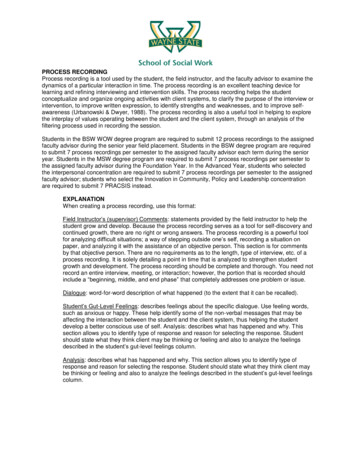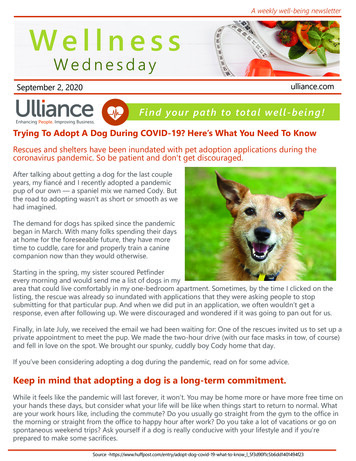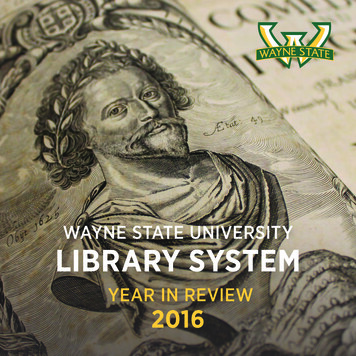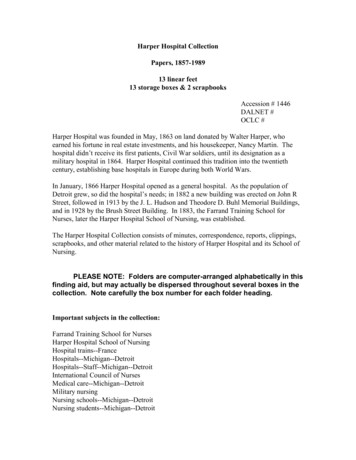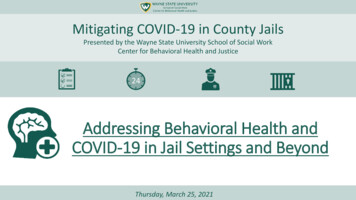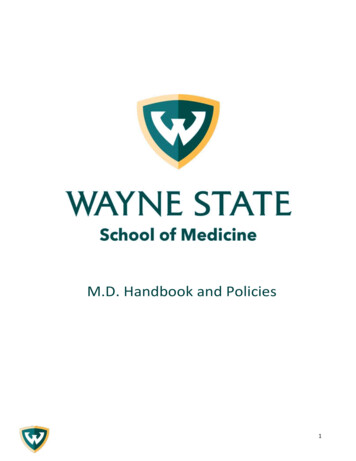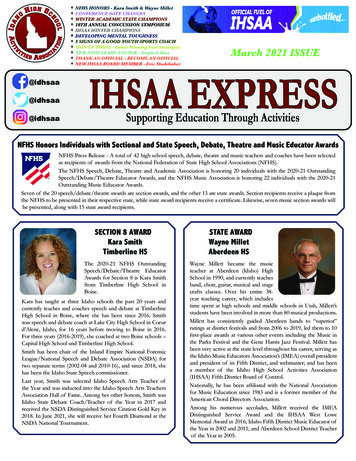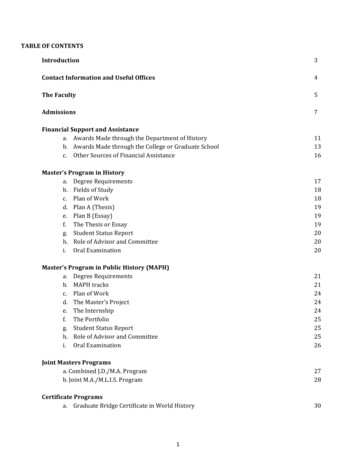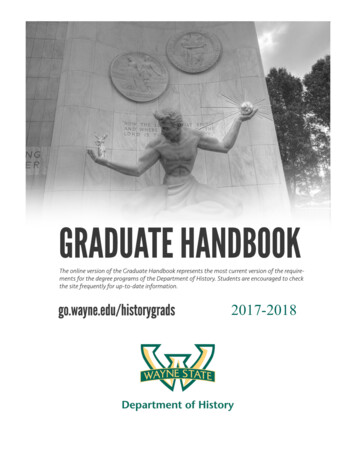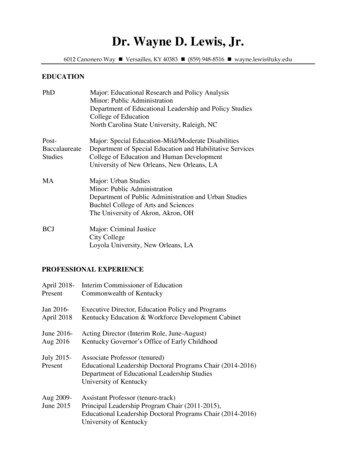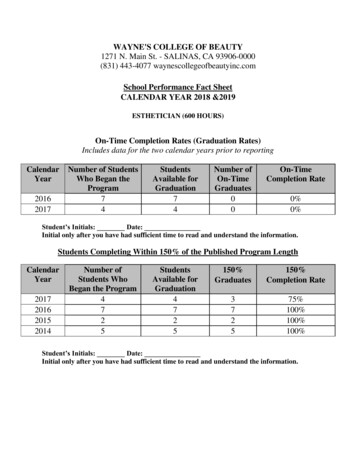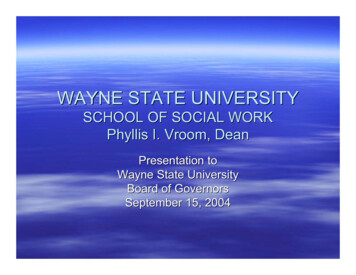
Transcription
WAYNE STATE UNIVERSITYSCHOOL OF SOCIAL WORKPhyllis I. Vroom, DeanPresentation toWayne State UniversityBoard of GovernorsSeptember 15, 2004
School of Social WorkBSW and MSW Program Fully Accredited byCouncil on Social Work Education until 2007
VISION To be the nation’s pre-eminent public andurban research school of social work
Mission As a School of Social Work in an Urban ResearchUniversity Discover, critically examine, transmit, and applyknowledge to advance social work practice andsocial welfare policy; and Through preparation of BSW and MSWPractitioners, Research and Service Contribute to social, cultural and economic justice,and the well-being of vulnerable and oppressedindividuals, families, groups, communities,organizations and society.
1.Major Goals: LearningEnvironment Nurture and sustain an exemplary Learningenvironment that supports preparation ofexcellent and ethical BSW and MSWprofessional practitioners in an everchanging, diverse, urban, global, andtechnologically advanced society, and toadvance urban social work practice andsocial welfare policy.
Learning Environment, cont. Maintain excellence in teaching and learningthrough the development and renewal of faculty Prepare BSW and MSW students for ethical,competent professional practice within an everchanging, diverse, urban and global environment Maintain the currency of the curriculum throughfeedback, evaluation, revision
Gourman ReportTop UndergraduateSocial Work ProgramBSW PROGRAM RANKED NUMBERONE!
U. S. News & World Report2004 RankingsWe’re still in the Top QuarterGraduate Social Work Programs– Howard University (DC)– Rutgers State University (NJ)– Simmons College (MA)– University of Denver– University of Kentucky– University of Wisconsin - - Milwaukee– Wayne State University– Yeshiva University (NY)
Faculty CompositionFull Time Tenured– Full Professor– Associate Professor Tenure TrackNon TrackLecturer1248931
Faculty Composition, Cont Part time– Classroom instructionInstructorsField LiaisonsFall Winter Summer37381918102
Office of Admissions andStudent Services Director Academic Services Officer and BSW AcademicAdvisor MSW Advisor Office Supervisor Three Clerical Staff–––Program SpecialistProgram Records Clerk SeniorStudent Records Clerk Senior
Academic Support Staff Three Secretaries– One secretary assigned to faculty, academicleaders, Associate Dean, Dean’s AdministrativeStaff– Two secretaries for full-time and part-timefaculty
Field Education Staff Coordinator of Field Education Assistant to Coordinator of Field Educationand Assistant Clinical Professor 5 part-time Placement Assistants Secretary to Field Education Office
Academic LeadershipAssociate Dean BSW Program Coordinator– BSW Committee MSW Coordinator– MSW Committee Lead Teachers Field Education Coordinator
Enrollment: 2003-2004 Fall 2003Winter 2004Spring/Summer– BSW17520564– MSW485469298– Total660674362
Field Education Number of Agencies238 Number of Field Instructors217 Number of Students (in Placement)515– 175 BSWs, 340 MSWs
Field Education, Cont:Agency Stipends (2003) Black Family Development, Inc. 14,000 Veterans Admin: Medical Ctr 16,000 Veterans Admin: Ann Arbor 12,000
Field Education, Cont. Students contributed 214,000 clock hours ofservice while learning Field Instructors contributed 14,000 clockhours of instruction time Agencies contributing 42,000 in stipends
Preparation for Practice Graduation: May 6, 2004 3293 Listed in Commencement Program Of these BSWs96 MSWs230 Total SW Grads 326
Curricular Innovations Continuation of M-FIA Child/Family Training(Grant Supported) Evaluation of Practice in Class and Field– Introduced at Field Education Recognition &Convocation Professional Seminar– Interactive Video and Workshops for In-comingstudents Integrative Graduate Curriculum– Positive Feedback from Two GraduatingClasses
2.Major Goals: Research PreEminence Sustain and expand a researchenvironment that fosters attainment of theschool’s pre-eminence as an institution thatcreates, tests, and disseminates knowledgethat advances social work practice andsocial welfare policies that promote humanwell-being
Major Goals: Research PreEminence, Cont. Improve ranking to top 25 schools Assure scholarly performance at a levelcomparable to the university’s nationalranking Strengthen and expand the school’sresearch infrastructure Increase participation of undergraduate andgraduate students in research andscholarship
Major Goals: Research PreEminence, Cont. PhD Program Center for SW Research, TechnicalAssistance, Professional Development 3,000,000 – 5,000,000 in Research Grants(Foundations, Corporations, Government)
Progress: Research Eminence PhD Program Proposal Submitted Business Plan for Center Research Grants: 1, 257,392 Preparing Faculty for Large GrantSubmissions
Preparing Faculty:Grant Submission President’s Research Enhancement:Interdisciplinary Group– Eileen Trzcinski’s w/ Jerrold Brandell & Team– Black/Kernsmith/Weisz on Lewandowski Team NIH –S W Research Group: 2 Faculty Russell Group:3 Faculty
Publication Productivity:2003 – To Date Journal Articles20.1 Chaps in Books3.0 Books6.0 Reports/Monographs1.0 Presentations (Nat’l/Intern’l Est.) Report Incomplete45.0
Publication Productivity Goals FY 00 – FY 02 Between 1-2 Per FacultyMember FY 02 – FY 04 Between 2-3 Per FacultyMember FY 04 – FY 06 3 Per Faculty Member
External Funding Grant Accounts: 1,363,506– Detroit Police Department (Weisz) 21K; Ends9/30/04– MI FIA Video Recording (Weisz) 75K; Ends12/31/04– MDCH (Black) 56K; Ends 9/30/04
External Funding, Cont. MI FIA (Bowers) 24,255; Ends 9/30/04 Ford Foundation (Santiago) 510K; Ends8/30/06 McArthur Foundation (Santiago) 150K;Ends 8/31/04
External Funding, Cont. New Detroit, Inc. (Sobeck); 302,549; Ends12/31/05 Michigan Non-Profit Research Program(Sobeck); 47,154; Ends, 8/31/04 U.S. Dept of Justice (Joint-50/50: CollinsEaglin, Black, Kernsmith, Weisz); 199,378;Ends 6/30/05
Advancement GoalBy 2006: 7,725,000Annual Goal HOW? Dean, BOV, MGO, Faculty & Staff, Alumni Major DonorsFoundationsCorporationsSmaller individual Donations
GOALS PhD Program Center for SW Research, TechnicalAssistance, Professional Development Scholarships, Fellowships, Stipends
ADVANCEMENT BOARD OF VISITORS Preparing to “go public” with the University Committees Fundraising Communications Public Relations
Donor Giving Gifts from 10/1/2001 to 3/31/2004: 820,180 Gifts from 10/04 to 6/04 121,815 New Endowed Scholarships: Allan & Harriet Gelfond Rachel Coleman New Planned Gift: Jean Teschner Total Endowed Scholarships
Scholarships Total Endowed 22 @ 667,478 Available Funds 187,533 Total Being Endowed 10 Other Scholarships 4 New Endowment Level 25K
Scholarships AwardedNumber of Students Awarded BSW14 MSW55Total69Amount Awarded General Fund 15,000 Endowed Scholarships 63,000Total 78,000
Student CharacteristicsFall 2003 BSW 183 MSW 419Total602
Student Characteristics, ContFall 2003 Full Time Students Enrolled BSW MSWTotal134230364
Student Characteristics, ContFall 2003 Part Time Students Enrolled BSW MSWTotal49189238
Student StatisticsCSWE Report – Fall 2003 School CensusFull Time Students BSW BSWTotalFemale123201324Male112940
Student Statistics,ContCSWE Report – Fall 2003 School CensusPart Time Students BSW MSWTotalFemale44161205Male52833
Student Statistics,ContCSWE Report – Fall 2003 School CensusOther Facts, 27% of BSW Students are Part Time 45% of MSW Students are Part Time 91% of BSW Students are Female 86% of MSW Students are Female 30% of All Students are BSWs
Student Statistics,ContCSWE Report – Fall 2003 School CensusEthnicityBSW MSW Af. Am/Blk64133 Nat Amer22 Asian Amer212 Latino/Hisp24 White (Cauc)113260 Unknown08Total183419
Donor Cultivation Events Events with Alumni Events with Donor Groups Planned Giving Workshops Donor Identification– Recommend one prospective donor
Development Committee Major Committee to Plan for Development &Fundraising (Joined by PR Chair)– John Talick, Development Chair– Juanita Doss, PhD, Public Relations Chair Some Preliminary Activities of Dean &Committee– Major Donor ID– Fund Raising Recommendations (PlannedGiving; “Recommend One;” Broad-basedgiving)– Tools for Fundraising
3. Major Goals: Quality of SchoolLifeFoster a strong sense of schoolcommunity Create a strong, vibrant, diverse schoolcommunity Support and improve the high quality ofservice to applicants, students, faculty andstaff Enhance physical environment andinfrastructure of the Thompson Home
Students Events Greater Detroit Association of Black SocialWorkers – Student Chapter PRESENTED “Gifted Hands – An Evening with Dr.Benjamin Carson,” Director of PediatricNeurosurgery at Johns Hopkins MedicalInstitution. Wednesday, March 3, 2004, CommunityArts Auditorium 6:00 p.m.
Student Events Student Organization Presented:– Dave Pelzer, national author, child abusesurvivor– His lecture: “The Real Heroes,” paying homageto educators, social workers, foster careworkers, law enforcement– March 25, 2004– Community Arts Auditorium, 6p.m.
School Events for Students Annual Social Work Career Fair (March)– 26 Agencies participated– 125 Students Participated Coalition for Community Social Work –“Take Back The Night” (April) Monthly Food & Fellowship : Dean, Faculty,Students Elizabeth N. Brehler Manuscript &Scholarship Competition (April)– Winner, Ms. Patricia Tauber, MSW Student
Student Support Services Seven Student Organizations, InterestGroups Individual Success Plan: 10 Individualized Educational Program : 200(60 new students in 2003-2004) Math/Research Tutor : 266; 200 BSW, 66MSW English Tutor: 101; 55 BSW, 46 MSW
4.Major Goals: Engaged School Expand mutually beneficial partnerships withexternal organizations, supporters andfriends of the school– Expand opportunities for the school to be apremier destination venue for diverse culturesto interact in an urban environment– Expand the visibility of the school locally,regionally and nationally through acomprehensive and coordinated program ofcommunication
Engaged School, Cont School – Agency PartnershipsEdith Harris Endowed Memorial LectureSpring Institute (Focused on agencypartnerships in May 2004)Continuing Education: New licensing Law,New Opportunities --- We’re Planning!!VisionsService and Service Research Projects
Engaged School, Cont. : Service Tri-Centennial Village (Habitat, Core City, SSW) Children’s Center & WSU: Center for Evaluation ofLearning Parents and Children Together (PACT) EthiopianJews visit WSU --- Thank you Alice Thompson andBFDI, Inc. (President Reid, School, College ofEducation, BFDI, Friends School, COE Pre-SchoolProgram, and others)
Engaged School, Cont Board of Visitors– N. Charles Anderson– C. Patrick Babcock– Richard J. Brehler– Juanitta Doss, PhD– Michael Earl– Annette S. Freedman– George D. Gaines, Jr.– Allen Gelfond
Engaged School, Cont Board of Visitors, cont– Paul L. Hubbard– Percy Key– Virginia Baumgartner King– Winston Lang– Guadalupe G. Lara– Lorraine Lerner– Mohamed Okdie
Engaged School, Cont Board of Visitors, cont–––––––––V. Lonnie Peek, Jr.Susan RogersEvelyn SmithLenora StanfieldLillie TaborJohn H. TalickAlice ThompsonEloise C. WhittenAngela B. Wilson
Engaged School, Cont Alumni and Alumni Activities and Visions Column 8,038 living Alumni 6,878 “Mailable Alumni” 917 Paid Alumni Alumni Events with Dean
SSW Alumni Association Events Annual Meeting and Awards Luncheon: March 25,2004 Social Worker of the Year: Arezell Brown, Director,School Social Work Services, DPS Citizen of the Year: Selma Goode, Coordinator ofWestside Mothers –Welfare Rights Organization Keynote Speaker: Michael J. Brennan, President& CEO of United Way)
Major Alumni Events with Dean Dinner with Alumni Board, June 22, 2004 Picnic with Alumni, June 25, 2004 Alumni Reunion, Summer Meet and Greet – TheDetroit Yacht Club, August 19, 2004 Meet the Dean – Washington, D.C., Maryland,Virginia – October 30, 2004
5. Major Goals: EducationalOpportunities Maintain Enrollment at 700 – 750Offer PhD ProgramExpand Continuing Educational OpportunitiesImplement Distance Education where appropriateIncrease Support for Highly Promising Students
FY04 Budget FY 04 Budget Total: FY 03 Budget total: 3,499,291 3,554, 800 52% Faculty Salaries 3% Academic Support Staff Salaries 21% Non-Academic Staff Salaries 19% Part-time Faculty Salaries 5% General Expenses
Summer Revenue & AnnualGiving Summer Revenue FY03: Summer Courses Workshops 50K
“Getting There from Here” Dean’s EffortsMajor Gift Officer EffortsFaculty and Staff EffortsBoard of Visitor and Volunteer EffortsAlumni and Students Efforts
THANK YOU
The Case StatementIn the school’s annual report (VISIONS Fall 2001) we outlined the framework of the strategicplan as developed by the faculty and administration of the school. They examined both strengthsand weaknesses in our programs and the needs of the communities that we serve. We have spenttime since then correcting weaknesses, building on our strengths and identifying specificprograms that will fill gaps in community programs. The result is a strong “Case Statement”submitted to the WSU administration and to the SSW Board of Visitors. Its major points areoutlined below, and will be the basis of our approach to our friends and colleagues when we talkwith them about the urgency of supporting the school.The legacy of the Wayne State University School of Social Work*Seven decades of educating outstanding and ethical professional social workers*Established a legacy as a practice-oriented school built on knowledge building and pioneeringresearch*Forged partnerships among community and faith-based agencies, schools and institutions*BSW program is ranked first nationally by the Gourman Report; the MSW program is in the topthird of national programsThe vision of the Wayne State University School of Social Work*Catapult the school into the highest level of excellence*Fill a community need for urban research specialists*Expand reputation as a practice oriented school*Fill the gap left open by current Michigan doctoral programs, providing a practice-orientedresearch programThe goals of the Wayne State University School of Social Work*Establish the WSU Doctoral Program in Social Work Practice ResearchEstablish an endowed chair and professorship, a scholar in residence and visitinglectureship for the program*Establish a Technical Assistance and Professional Development CenterEndow funding for ongoing research and training capacities, its program modeldevelopment and service learning projects conducted by graduate students and faculty*Expand recruitment, retention and outreach resourcesEndow fellowships for graduate studentsEndow lectureships for the dissemination of knowledge of best practices to communitygroups and human service organizationsEndow an unrestricted investment fund for research stimulation and developmentprograms for faculty and studentsIncrease undergraduate and graduate scholarships
Case Statement SummaryAndProfiles of Faculty Research, Teaching and Practice InterestsWayne State University School of Social WorkThe LegacySocial Work is a profession that improves the lives and life circumstances of individuals,families, groups, and communities. Social work practice has increased the workproductivity of the recovering substance abuser, the worried parent of a formerlyintractable teenager, and a worker bedeviled by oppressive mental depression. It has helpedto restore school communities to peaceful learning environments through programs focusedon violence prevention, peer counseling, and inter-group understanding, and through crisisintervention counseling. It has returned to healthy social functioning traumatized children,youths, and adults suffering from the post-traumatic stress of unimaginable violence.Social work has also diminished the loneliness of elderly nursing home residents andlessened the sense of abandonment of persons with HIV-AIDS. It has increased parentingskills with early childhood and family treatment programs. It has forged importantpartnerships between community-based and faith-based organizations, health care andrecreational organizations, and schools and social welfare organizations. It has helpedcreate relationships to build safe, attractive, nurturing communities with strongneighborhood networks, creating opportunities and conditions for neighbors to help eachother. “Love is not enough” (Bettelheim); helping results from a heartfelt commitment tothe well-being of people, a determination to create environments that sustain and nurturethem (Chestang), and the process of learning the knowledge, values, and skills of socialwork practice.For seven decades, the Wayne State University School of Social Work has contributedimportant knowledge of how to make a difference through social work practice. Today theSchool continues that tradition of excellence and its essential mission: to prepareoutstanding and ethical professional social workers who can make a substantial impact onboth the development and improvement of people, whether individually, in families,groups, organizations or in communities, and the societal conditions that affect them. Theschool’s legacy as a practice-oriented school is built on knowledge building and pioneeringresearch in partnership with agencies and strong curricula to teach practice effectiveness.Innovations in research and practice-oriented theory, particularly in partnership with socialwelfare agencies, continue to make the school distinctive.The Gourman Report ranks the WSU School of Social Work undergraduate program firstamong 459 national programs. The masters program is ranked by US News & World Reportin the top fourth, nationally, one of only two graduate programs in the top half that doesnot have a doctoral program.This is the strong foundation upon which we are building our vision.The VisionThe vision is to catapult the school onto the next and highest level of excellence. The vision
Case Statement Summary: School of Social Workwill fill a community need for urban research specialists capable of strengthening andexpanding the school’s reputation as a practice-oriented school and redress the lack of a2research and practice-oriented doctoral program in the state. The vision builds upon ourintellectual legacy as a pioneer in practice-oriented research. The vision is supported by ournational ranking. The vision is realistic.The NeedsThe first step to making the vision reality is to establish the Wayne State UniversityDoctoral Program in Social Work Practice Research. A Doctoral Program will build on thecurrent research foci of faculty members, attract nationally recognized faculty membersthrough an endowed chair and professorship, a scholar-in- residence and visitinglectureship, increase our attractiveness to students nationally and internationally, andenable us to win external national research funding. The university’s mission exhorts us to“apply knowledge that contributes to the positive development and well-being ofindividuals, organizations and society.” The doctoral program links three universitystrategic directions: enhancing the learning experience, attaining research preeminence and,through community involvement, sustaining the engaged university.The second component of our vision is the establishment of a Technical Assistance andProfessional Development Center to disseminate research and theory directly into practice.This center will link the applied research and training capacities of the School of SocialWork with com
WAYNE STATE UNIVERSITY SCHOOL OF SOCIAL WORK Phyllis I. Vroom, Dean Presentation to Wayne State University Board of Governors September 15, 2004. School of Social Work BSW and MSW Program Fully Accredited by Council on Social Work Education until 2007. VISION To be the nation’s pre-eminent
